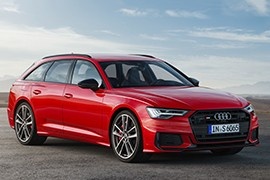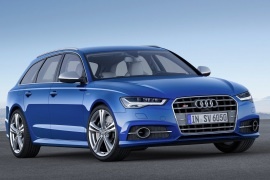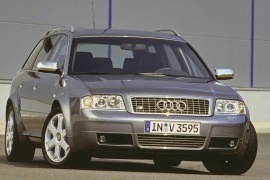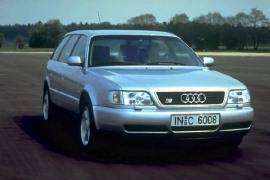
AUDI S6 Avant
Generations Timeline, Specs and Pictures

Not all manufacturers are calling their estate vehicles as “station-wagon” or “wagon”.
Audi uses the term “Avant” as a remembrance of their two and a half box body-style models since the ’80s. But it is a station wagon, and a big one. The S6 Avant has the same engine as the rest of the S-series in S6 and S7 guise. But the supplemental weight makes it run slower from 0 to 62 MPH (100 kph) by a tenth of a second, stoping the clock at 5.1. True, that is not bad at all! Plus, you have a huge trunk and with the rear seats folded it is like a camper-van for three people.
Since it is an S-version, it sits lower then the non-S station wagon from Audi. Not by much, but it sits 20 millimeters (0.8 in) lower than its siblings. On the inside, there is plenty of room for five and you can scare them with nice launches since the vehicle is well suited for this kind of treatment.
All the seats are bucket-type so the occupants will be held in place during hard-cornering.
For outside Europe, the S6 Avant is offered with a twin-turbo V6-gasoline engine developing 450 HP and 600 Nm (442.5). This version is also fitted with the electric supercharger (EPC).

Audi introduced a mid-life cycle refresh for the A6 range and involved the S6 version in the process, creating an even faster station wagon for the S6 Avant.
Starting with September 2015, all cars registered in the European Union must have the Euro 6b emission standard compliant, and Audi had to adapt. With all eyes on it, the carmaker had to adapt and adjust its engines but, instead of limiting the power, it gave even more for the S-version A6.
The S6 and its more potent brother RS6 were some of the most powerful sleeper vehicles on the market. Their station-wagon shapes didn’t leave too many clues about their performance. In the S6 Avant shape, the large estate vehicle featured a similar shape to the rest of the range. Its sliver casings for the door-mirrors and the small specific badge on the singleframe grille were hard to notice in traffic. The carmaker offered the S6 with a standard adaptive air-suspension that lowered the ground clearance by 20 mm (0.8”) for less ground-effect drag.
Inside, the carmaker installed sport bucket-seats at the front with integrated headrests. Their high-bolstered design made them very supportive during hard cornering. Audi installed a pop-up retractable screen for the MMI (Multi Media Infotainment) unit on the dashboard, with a turning knob controller between the front seats but without a touch-screen. Its instrument cluster featured four analog dials and a TFT display in the middle. In the back, the S6 Avant offered room for three, despite its tall center transmission tunnel. The split-folding bench was wide enough for that.
Under the hood, Audi kept the older 4.0-liter twin-turbocharged gasoline engine but increased its power by 30 hp when compared to the non-facelifted S6 version.

With the world financial crisis over and the re-shaped economy rising, Audi rushed to offer a new S version for the fourth generation of the A6 Avant.
Audi launched the fourth generation of the A6 in early 2011 for the European market, and one year later, it was available everywhere else. Like all its predecessors, it was available in two body versions: sedan and station wagon, the latter being traditionally named Avant by the carmaker. The S-model was a sportier version and featured a few differences when compared to the standard model.
Audi had a special package named S-line, which the customer could add on any less-powered version of the A6 Avant, while the S6 was the real deal. It sported silver door mirror caps and a red and gray logo on the massive, singleframe grille. On the sides, Audi installed V8T badges on the front fenders, while at the back, it installed an aluminum-like shield under the bumper, flanked by two twin elliptical pipes. At the top of the tailgate, the carmaker added a roof spoiler.
Inside, the S6 Avant featured an elegant yet sporty interior. Audi placed an S6 badge on the steering wheel and embroidered it on the seatbacks of the front seats. The same logo appeared on the instrument panel on the center TFT display between the tachometer and the speedometer. A few carbon-fiber trims adorned the door panels and the center console.
But the S6 Avant was about what was under the bodywork. Audi installed a twin-turbo 4.0-liter V-8 under the car’s hood. It paired it with a seven-speed automatic (dual-clutch) gearbox. It sent the 420 hp to all corners via a Torsen center differential, not a Haldex system.

The 2008 Audi S6 Avant combined three attributes: a big trunk, a luxurious interior, and a supercar engine, resulting in a fast station wagon that could put many sportscars behind.
Audi unveiled the C6 Audi S6 at the 2006 North American International Motor Show in Detroit and brought a facelifted version for it in 2008. The car was available as a sedan or a station wagon.
The 2008 S6 Avant didn’t look like a vehicle able to top the zero to 60 (0-97 kph) in less than six seconds. Its front fascia showed little about what the vehicle was capable of. The new, refreshed look showed five LEDs on each side, installed lower on the bumper, as daytime running lights. Its singleframe grille with the gray and red S6 badge on it. At the back, Audi installed new LED taillights that enhanced the car’s look from behind. Four oval exhausts flanked the rear diffuser.
Inside, Audi introduced a new MMI system with a special combination of CD/DVD/Navigation and a 40 GB hard disk to store MP3s or up to 5000 addresses. That came to complete the exclusive interior with high-bolstered front seats with integrated headrests for the front occupants. As a station wagon, the S6 Avant offered a vast trunk room, with 546 liters (19,2 cu-ft) of space that could be extended up to 1660 liters (70,3 cu-ft) of space with the rear seats folded.
Under the hood, the carmaker kept the same V-10 engine carried over from Lamborghini Gallardo but detuned to 435 hp. Both the automatic transmission and the all-wheel-drive traction were standard features for the S6 Avant.

The 2006 Audi S6 has received also a station-wagon version.
It was the model with the biggest gasoline engine ever installed inside an A6 shell, sedan or station-wagon.
On the big, single-frame grille with chromed accents for its rim and vertical bars, the red and silver S6 badge stood discreetly. Five LEDs on each side, installed under the headlights, were telling a story: one LED for each cylinder under the hood. There were some other details such as V12 badges on the fenders and silver rear-view mirror cases, but the last thing that most of the other motorists on the road would see were the four oval exhausts were nicely integrated into the rear bumper. The trunk room was vast, with 546 liters (19,2 cu-ft) of space, that could be extended up to 1660 liters (70,3 cu-ft) of space with the rear seats folded.
Inside, there was a new infotainment unit, named MMI which integrated the navigation, controls for heating and ventilation, and audio unit. It was an all-in-one system accessible via a rotary knob on the center console, with few buttons around it.
The 5,2-liter V10 engine was on the shelf and it already found its way into the A8 model. But the engineers didn’t want to give the same power to the S6 as in the flagship model. So, they detuned it to 440 hp. For the transmission, a 6-speed Tiptronic gearbox was supplied by the ZF and a Torsen center differential with a 40:60 torque distribution was in place to enhance the driving experience.

Following the launch of the second generation of the A6 station-wagon in 1998, Audi introduced the more powerful version S6 Avant in 1999, along with the S6 Sedan.
The second generation of the Audi S6 Avant was based on the newly-developed C5 platform. It was more than an A6 Avant with different badges. It was offered with more powerful engines and stiffer suspensions that made the car planted to the road. The all-wheel-drive was fitted as standard.
There were some differences between the fierce S6 Avant and a regular A6 Avant. The light-alloy wheels had the design inspired by the Audi TT. The front fenders and the sills were slightly wider. The lowered and stiffened suspension was engineered specially for the S6 range. Two exhaust pipes with chromed tips were fitted as standard on the car. A badge on the grille and one in the back completed the exterior differences.
Inside, the S6 featured high bolstered seats for the front passengers, which ensured better side support on cornering. A set of sport-bucket seats designed by Recaro was on the options list. The rear split-folding bench was kept, just in case something long and heavy had to be delivered fast on the other side of the country.
On the engineering side, the S6 Avant was a completely different car than the rest of the A6 range. The all-wheel-drive system was tuned for performance, with Torsen center differential, and electronic differential locks both front and rear (EDL) managed by the Bosch ESP system. The engine was a 4.2-liter V8 with 340 hp, 40 more than the standard Audi A6 4.2-liter. The car was available with either a 6-speed manual or a 5-speed auto, with manual override for changing gears (Tiptronic).

Audi renamed the last generation of the 100 Avant as A6 Avant when it introduced its facelifted version in 1994, and it also offered it with a sportier version named S6 Avant.
While Mercedes-Benz and BMW started to offer a more powerful version for their mid-size sedans, Audi came with the idea of offering a sportier version for its mid-size station wagon vehicle, the S6 Avant. It offered something different than its main competitors and placed its bets on those who still enjoyed fast cruising but still able to carry a family of five and a trunk full of bicycles.
The S6 was based on the same platform as the last Audi 100 model but with serious upgrades underneath. From the outside, it was a sleeper, without too many details that could tell the difference. The main differences were the red and gray badge on the front grille, the unique alloy wheels, and the tiny roof spoiler at the top of the tailgate.
Inside, the S6 offered room for five and comfort for all of them, with sport bucket seats at the front and leather upholstery. For the kids’ bicycles, the S6 Avant offered a big trunk in the back. With the rear seats up, it could get up to 390 liters (13.8 cu-ft) of space and up to 1,310 liters (46.3 cu-ft) with the rear seats folded.
Under the hood, there was an inline-five engine, the same as the original Audi S1 rally car. The carmaker replaced the turbocharged gasoline unit later with a naturally aspirated 4.2-liter V8 unit. While the 2.2-liter was available with a 6-speed manual (5-speed for the U.S. market) only, the V8 was fitted as standard with a four-speed automatic, and a 6-speed manual was offered as an option.























































